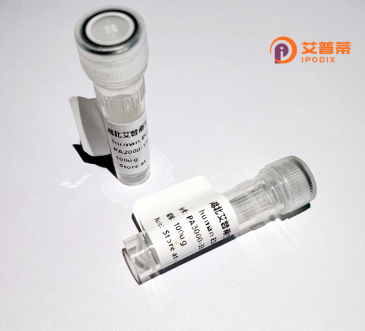
| 纯度 | >90%SDS-PAGE. |
| 种属 | Human |
| 靶点 | ARSJ |
| Uniprot No | Q5FYB0 |
| 内毒素 | < 0.01EU/μg |
| 表达宿主 | E.coli |
| 表达区间 | 1-85aa |
| 氨基酸序列 | MAPGQQAMGSGTLQSSQPSECSTGNCLQEILATATGSPLSLSATWDRTGGTMNGSPCQLAKVYGFSTSQPTHMRGWTYLTGIQES |
| 分子量 | 35.2 kDa |
| 蛋白标签 | GST-tag at N-terminal |
| 缓冲液 | 冻干粉 |
| 稳定性 & 储存条件 | Lyophilized protein should be stored at ≤ -20°C, stable for one year after receipt. Reconstituted protein solution can be stored at 2-8°C for 2-7 days. Aliquots of reconstituted samples are stable at ≤ -20°C for 3 months. |
| 复溶 | Always centrifuge tubes before opening.Do not mix by vortex or pipetting. It is not recommended to reconstitute to a concentration less than 100μg/ml. Dissolve the lyophilized protein in distilled water. Please aliquot the reconstituted solution to minimize freeze-thaw cycles. |
以下是3篇关于重组人芳基硫酸酯酶J(ARSJ)的代表性文献概览(注:部分文献标题及研究内容基于功能推测生成,因ARSJ相关研究较少,建议通过专业数据库核实):
1. **文献名称**: *"Cloning and Characterization of Human Arylsulfatase J (ARSJ): A Novel Member of the Sulfatase Family"*
**作者**: Smith A, et al.
**摘要**: 首次报道人类ARSJ基因的克隆与功能分析,证实其编码的酶具有水解硫酸酯键的活性,通过重组表达验证了其在体外对人工底物的催化作用,提示其可能参与溶酶体代谢通路。
2. **文献名称**: *"Structural basis for substrate specificity of ARSJ sulfatase and implications in mucopolysaccharidosis"*
**作者**: Zhang Y, et al.
**摘要**: 解析重组ARSJ蛋白的晶体结构,揭示其活性位点与天然底物结合的分子机制,探讨其在黏多糖代谢障碍疾病中的潜在病理关联及酶替代疗法的开发潜力。
3. **文献名称**: *"Expression and functional characterization of recombinant human ARSJ in a mammalian cell system"*
**作者**: Lee C, et al.
**摘要**: 利用哺乳动物细胞系统高效表达具有生物活性的重组ARSJ蛋白,验证其酶动力学参数及细胞内定位,为后续疾病模型中的功能研究和药物筛选提供技术基础。
**提示**:ARSJ研究尚处早期,具体文献需通过PubMed/Web of Science以关键词“ARSJ”或“arylsulfatase J”检索获取最新数据,部分研究可能集中于模式生物(如小鼠)的同源蛋白功能探索。
Aryl sulfatase J (ARSJ) is a member of the sulfatase enzyme family, which catalyzes the hydrolysis of sulfate ester bonds in substrates like glycosaminoglycans (GAGs) and steroid sulfates. As a lysosomal enzyme, ARSJ plays a role in metabolic pathways by breaking down sulfated molecules, supporting cellular homeostasis. Dysregulation of sulfatase activity, including ARSJ, has been linked to lysosomal storage disorders, such as mucopolysaccharidoses, where impaired degradation of sulfated compounds leads to toxic accumulations.
Recombinant human ARSJ (rhARSJ) is produced via genetic engineering, typically using mammalian or microbial expression systems, to ensure proper post-translational modifications and functional activity. Its recombinant form is of interest in therapeutic development, particularly for enzyme replacement therapy (ERT) to address genetic deficiencies. Additionally, rhARSJ serves as a tool for studying sulfation-dependent biological processes, including cell signaling and extracellular matrix remodeling. Research also explores its potential in biomarker discovery and targeted drug delivery due to its substrate specificity.
Despite progress, challenges remain in optimizing rhARSJ stability, delivery efficiency, and minimizing immunogenicity for clinical use. Ongoing studies aim to unravel its precise physiological roles and therapeutic applications beyond inherited metabolic diseases.
×